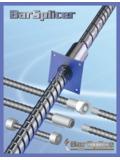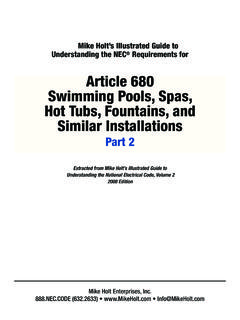Transcription of Rope-to-chain splices - John Danicic
1 50 GOOD OLD BOAT January/February 2007In the November 2006 issue, John Danicic wrote about installing an anchor windlass. One remaining issue is the creation of a strong rope -to-clain YOU ARE USING A rope -AND- chain combination windlass to deploy and retrieve your anchor, you might wonder about the connection between soft fl exible rope and hard chain . While deploying, you will hear the windlass change from a clanking racket, as the chain runs through, to a quiet hum, as the rope snakes out. That change in sound is a change in strength. An are likely to have three-stranded anchor rode in your chain locker. It s stiff to handle and tends to kink after the windlass stows it below a few times. It s useable, if not the best, with most windlasses. Suitable splices for three-stranded rope include the back splice and the elongated splice (see Pages 51 and 52).Square line, also known as eight-stranded plaited rope , is a single-core, extremely fl exible and soft rope that resists kinking and coils neatly into the anchor locker with little or no tending.
2 Because of its fl exibility, the same length of eight-stranded plaited takes up less stowage space than the same length of three-strand. If you are installing a new windlass and need a new line and chain , go the extra mile and purchase single-braid eight-plait. This is the line recommended by many windlass manufacturers. Suitable splices for this one include the back splice to one link and a version of the elongated splice for square rope (Just the fi rst of these is illustrated here, on Page 53). When you re gathering your splicing tools, shown above, be sure to include a hot knife. An old solder gun serves this purpose for me. A hot knife will sever and melt nylon fi bers together leaving a relatively clean cut that won t unravel. Rope-to-chain splicesSolving the problem of joining one to the other Back splice, eight-plait, single coreBack splice, three-strandElongated splice, three-strandby John Danicic 51 This one is called a back splice to a single link be-cause it is inserted through a link and then turned 180 degrees back and threaded against the twist of the line.
3 When this splice is under load, the rope s twist tightens to lock the backed strands. The key to this splice for Rope-to-chain windlasses is to keep it loose. Don t snug it up on the chain too tightly. Remember, the splice will need to make a 180-degree turn on some and wrap. Mea-sure off a foot of rope and tightly tie a constrictor knot with strong , decisions. Unravel the strands. Use a hot knife to seal the ends. Tape them tightly. From the constrictor knot, flatten the strands and decide on a middle strand. I like to mark this middle strand 2 and the outside strands 1 and 3. Num-ber it any way you want, but the strand you deter-mine to be the middle is the starting begin. Start with this middle strand, Number 2, and insert this into the ways. Insert the other two strands into the link in the opposite direction from Number the twist. The strands tend to unravel a bit at this point so it is important, for neatness, to keep them tightly tuck.
4 Take Number 2 and go over a strand and then under the next strand. Always thread the strand against the twist. This is called a tuck. Over under. Take the Num-ber 1 strand and go over one strand and then under the next strand. Do the same with Number 3. If you did it right, all three strands should appear to come out of the twisted rope at the same level but from between different strands. This is the most critical part of the splice. If you get this right, you are home all the strands tight against the link and the constrictor knot but not so tight that the link can t move freely on the line. Yes, this is a poten-tial source of chafe. If you make it too tight, the chain link and rope will form a hard spot and could bind or run roughly through the away. Do two com-plete tucks with all three strands, threading through against the wrap. Keep everything flowing in a counter twist pattern.
5 Weave each over the next strand then under the one after down. After two tucks for each strand, take your hot knife and from where the strand emerges from under a strand cut off one third of the threads of each strand. Leave inch or a bit more sticking out. You can clean these ends off and trim. Complete two more tucks with your now thinner to the finish. Cut off another third of the threads. Finish tucking the remains of the strands until there are no more to tuck. Pull firmly on the splice to smooth it out. Clean up the protruding threads, leaving about inch sticking out. All done. This splice is not as flexible as the elongat-ed splice and may jam up in windlasses if you weave your strands too tightly. Three-stranded back splice to a single link12321321321323152 GOOD OLD BOAT January/February 2007 This is a splice that I have not seen very often. It s easy to make, flexible, and seems to be very firm and strong.
6 This splice runs quietly through my windlass and into the chain locker below. It lacks that lump of stiff material com-mon to other splices that tends to make a loud, sick-ening clunk no matter how loose you make Hylas is the inven-tor of the Spade anchor and of the elongated splice. He calls this splice the only safe way to connect anchor warp to anchor chain . He explains, You can also connect it with an eye-splice over a thimble and a shackle. It will be absolutely safe but has difficulty go-ing through the bow roller, windlass, and then into the chain locker. The other way is the back splice, passing the strands through the last chain link. Although there are publications that prove that the loss of strength is negligible, I don t like it, as every time a rope is sharply bent, it will lose about half its strength. Alain doesn t remem-ber where he learned this splice. I ve been sailing for about 45 years now, including 13 years of full-time cruising.
7 During this time, I learned quite a lot. (A square-line version of the elongated splice also exists.)On your mark. Start with 12 to 14 inches of line. Make a substantial con-strictor knot with waxed sail Unravel the strands after hot cutting and taping the strand ends. Number or mark each stand to differentiate one from and out. Insert Number 1 and Number 2 through the first link from opposite sides. Draw it up tight to the constrictor knot. Insert Number 3 in the second link. Keep the strands rolled tightly so they don t begin to After you have the first two links done, the rest is just a repeat. Two in from opposite directions, the third skips up to the next link. Do this until you run out of it off. Using heavy waxed twine and a sail needle, tightly bind the ends to the chain links and then use the hot knife to cut off the excess. Keep the melted plastic ends as small as the bend.
8 This elongated chain -to-warp splice is very flexible and goes though my chain -to- rope windlass with little or no elongated spliceHand Crafted, High Efficiency LightNew Night-Vision OptionAlpenglow Lights use the latest compact fluorescent and technology for unmatched efficiency and light quality. The attractive wood fixture is available in several models including night-vision and splash-proof. Prismatic lens designed for wide-angle illumination. Dual power switch allows choice of bright light or gentle glow. Also, high-efficiency brass reading light. Brochure includes helpful information on selecting cabin Marine Box 415 Eureka, MT 59917 53 Square line, also known as eight-plait, is the line recommended by windlass manufacturers. Brait, by Yale Cordage is shown in the illustrations. If you re in the lucky (or unlucky) posi-tion of needing new anchor rode, this is the way to right and left.
9 Eight plait, sometimes called square line, has four distinct surfaces or sides. When you turn the rope 90 degrees, its top strands appear to rotate as a pair to the right; turn it another 90 degrees, and the top strands or pairs will rotate to the left. On each of the four sides there is a pair of strands rotating together in the same direction. Study the rope before you begin and learn the left and the pics. Count 10 pics (or paired strands of yarn) back from the end and tie a constrictor knot tightly with waxed unraveling. Unravel the rope to the knot and separate the strands into four pairs. Each pair has two strands of material traveling in the same direc-tion. Mark each pair R for right-rotating and L for left-rotating. I marked each pair with different colors to help with the photos. Tape each pair s ends, to form a point. This will help speed the tucking , then out. Take a left pair and a right pair and thread it through the link.
10 Then take the other left and right pairs and thread them through the link from the opposite direction over the top of the other two tricks. Here s where it gets tricky. Turn the line so you can clearly see the rotates to the left weave on the body of the line. Take a right pair and slip it under the closest left-rotating pair. You may need to use a fid or a pencil to create this tunnel. Remember, right pairs slip under left pairs from right to left. You will notice that your tucked pair will have a partner weave that it travels along tricky. After you tuck both right pairs, turn the line so you can see the rotates to the right weave. Left pairs tuck under right rotat-ing weave from left to right. Confused yet? At this point you have done four tucks. Examine your work. Are both right pairs running from right to left under a left rotating pair? Do they have a partner weave under them running in the same direction?






